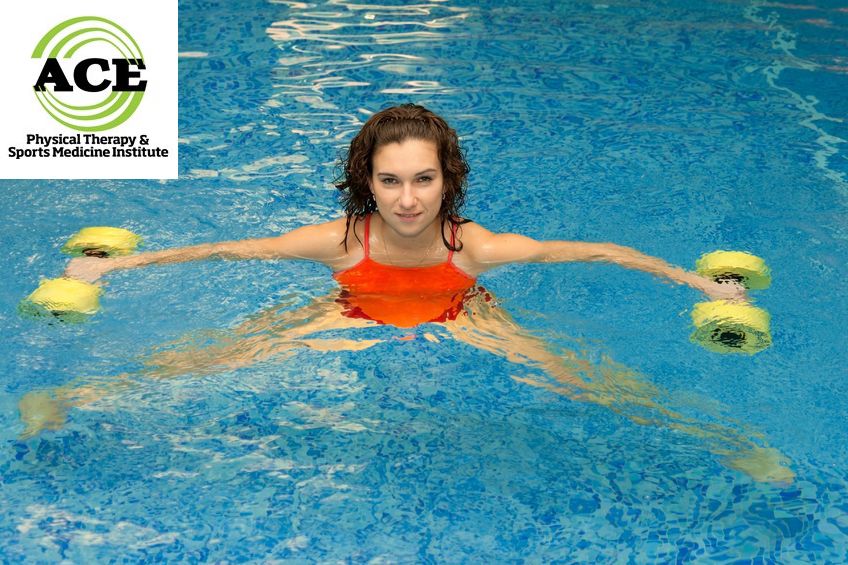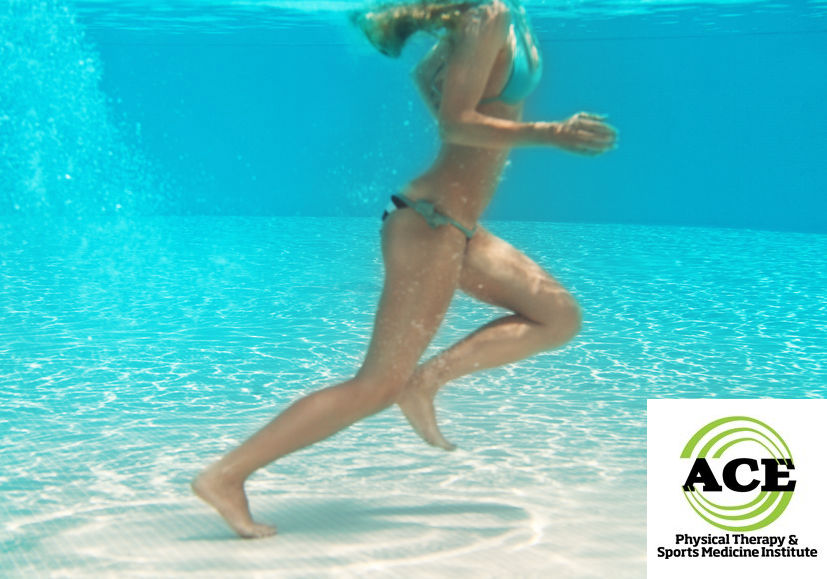FUN WATER EXERCISE

Tid Bits of Info
- Exercising in the water for 1 hour can burn in excess of 500 calories.
- Exercising in water makes you feel about 90% lighter.
- Water exercise is low impact and good for anyone with degenerative joint disease.
- Water exercises have been linked to a decrease in fall risk and osteoporotic changes.
- Seek the advice and treatment from a Physical Therapist if you develop pain and part of the treatment protocol might be in the water.
On a warm day, there’s nothing like jumping in a pool of cold water. It’s not only refreshing but can be a great place to work out. Water-based exercise is usually just as effective as land-based exercise and there’s no limit to the types of exercises you can perform. The water provides a buoyancy to the human body. This reduced effect of gravity on the body makes it easier for almost everyone to enjoy some form of exercise in the water.
Any fitness program should work to increase cardiovascular conditioning, strengthen the muscles, and increase the flexibility throughout the soft tissues of the body. Here are some of the ways a well-designed water exercise program will address each of these issues.
Aerobics:
Water can provide an excellent atmosphere for a cardiovascular workout. The resistance that is felt during the movement through the water forces the system to work harder. The increased heart rate helps to strengthen the heart and improve the cardiovascular fitness. A couple of possible activities that will help develop the cardiovascular system are water walking and jogging, water aerobics (organized class), and water jumping (simulate jumping rope). All of these activities can elevate the heart rate significantly. The goal is to raise it to at least 60% of your maximum heart rate (approximately 220 – your age). Anything over 60% will be a benefit for the cardiovascular system. Exercising at roughly 70% of your maximum heart rate for 30 minutes or longer at least 3 times per week has been linked to a better quality of life and in some studies living longer.

Strength:
Strength gains can occur while working out in the water providing the musculoskeletal system is “over loaded” with some form of resistance. The water can be used to strengthen the upper and lower extremities. The addition of hand paddles can increase the amount of resistance that is encountered during the movement of the arms through the water. Almost any exercise that is performed on land can be mimicked in the water. The goal is to forcefully move the limbs through the water. Strength gains will occur, but they will require a great deal of effort. The effects of gravity will be significantly reduced during the exercise routine. The same training principles can be used in the water when attempting to gain strength. The resistance must be increased gradually and number of repetitions should remain between 5-15. In most cases, high resistance is used with a lower number of repetitions when attempting to gain strength.
Flexibility:
Being “flexible” can be defined as the soft tissues of the body are able to move through a full range of motion easily and with very little pain or discomfort. The soft tissues that are most commonly found to cause restrictions to movement are the static stabilizing structures of the musculoskeletal system. These tissues are the consistency of leather and need to be stretched repeatedly in order to develop greater flexibility. Movement in water can be very relaxing and “free.” The weightlessness of the limbs in the water makes it easier to move them through a larger range of motion. This slow, deliberate motion can aid the increase in flexibility and provides a dynamic stretch to the soft tissues of the body.
Physical Therapy can utilize water therapy to help a person rehabilitate an injury. The ease in motion, due to the reduction of gravity, can increase the amount of movement in an injured body part. Physical Therapists can help you determine what exercises can be performed in the water to help in the recovery process. Many lower extremity injuries benefit greatly with water walking and running and these activities can be performed much sooner in the rehabilitation process due to the elimination of gravity. Likewise, upper extremity movements are accomplished more easily in the rehabilitation process for the same reason.
Water can provide a great place for people to have fun and exercise at the same time. Nearly any land based exercise can be modified and performed in the water with similar results to the human body. All aspects of physical conditioning can be “worked on” in the water.

























Depending on an individuals fitness level, comorbidites, and overall joint health aquatic therapy or even exercise will be highly beneficial for them and this article demonstrates that. Aquatic therapy helps to decrease the load placed on joints while giving the added benefit of exercise. Cardiovascular and strengthening programs are both options when it comes to fitness gains in the water. Individuals can do things such like tread water for an increase in their heart rate to help heart health, lung function, and burn calories all while being less impactful on the joints for individuals who may need exercise but can’t do to long without having joint pain. This time of year pools are opening and even gyms have exercise programs, if their is a pool, geared toward aquatic exercise. The water works as a great resistance for both strengthening and for cardiovascular health. Individuals are also able to purchase floating devices that work at adding more resistance to their program such as styrofoam dumbbells, styrofoam boards, and pedal bicycles that go underwater. Aquatic doesn’t have to apply only to those who have joint degeneration or pain but can also be for the well trained athlete and be incorporated greatly this summer with family, friends, and begin to show that the pool isn’t only a place to lay out and get some sun but a place to make fitness gains as well.
Summer season makes water-based activities more available for everyone to take advantage of and makes exercises fun for anyone who finds exercises boring and mundane. This article explains that “nearly any land-based exercise can be modified and performed in the water with similar results to the human body and all aspects of physical conditioning can be “worked on” in the water.”
I like that this article gives people more specific ideas about how to exercise in the pool. I think this is especially beneficial for elderly people with degenerative joint disorders. Pool exercise not only decreases the load on their joints but it allows them to increase their vitamin D levels and socialize with others.
I was so excited to see a blog on aquatic exercise and I wanted to jump up and down as an aquatic instructor for over 40 years and say “Yay for Aquatic Exercise” since I firmly believe in its benefits, especially for range of motion, core control, conditioning and falls risk.
I would caution the reader on the osteoporotic benefits though, especially those who may have an osteoportic condition. Though studies have shown a 24 week high intensity aquatic exercise program can increase bone formation marker P1NP and decrease the bone resorption marker CTx , this was in comparison to sedentary individuals. Research shows to affect bone metabolism or decrease fracture risk both forces of gravity and muscle loading must be essential elements of a therapeutic program. As an aquatic instructor I would say the evidence supports shallow water weight bearing aquatic exercise to increase balance skill, strength, endurance and self efficacy compared to no exercise but it would be reasonable to have to incorporate land based exercises to maximize osteogenic effects.
Finally, it is well known that water has a bradycardic affect on the heart rate and therefore if monitoring intensity level by pulse rate an aquatic deduction needs to be applied. Unfortunately this becomes cumbersome to determine so using the Rate of Perceived Exertion (RPE) approach is usually appropriate for water exercisers.
This past week water was utilized as a rehab approach for 2 clients. One was having difficulty with rising up on toes but they loved water and were planning to return to their water ex program, so it was suggested they do the heel risers exercise in the pool to allow buoyancy to help with the plantarflexion movement starting deeper at first and working shallower until they were stronger and then transition to land. Another client admitted fear of falling but enjoyed water so water walking was suggested.
In touting water exercise though there was a missed opportunity to educate diabetics on foot care in the water. Wear shoes preferably with appropriate support and dry feet throughly after sessions!
Great thoughts Jeanne! Nailed it!
Learned so much from your comments. Thank you.
I agree with this post. I think water exercises are often over looked, especially during the summer months when people actually enjoy going to the pool. This was a good general overview of what can be performed in a pool.
Also water activities are good for people who have weight bearing intolerance, balance issues, and people who would benefit from unloading their spine.
Another area of aquatic therapy would be with athletes in return to sport. The water would allow them to perform exercises in water before theyd be able to on land.